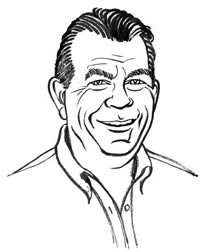September 2006 ISSUE

President’s Notebook
The Foundations of Our Professions
BY DAVID CHALCROFT, P.ENG.
APEGGA President
One of the delights of serving as the 87th President of your venerable Association is the opportunity to learn about our professions from the many members who interact at the Association level. Let me share with you my evolving understanding of what makes our professions great and why they are so important to society.
The foundations of our three professions are like a three-legged stool, or maybe more appropriately a three-caisson-supported slab founded on professional bedrock. (How’s that for wrapping engineering and geoscience together in my metaphor?)
Education
Caisson One is our formal education. Whether it be engineering, geology or geophysics,
advanced technical know-how is the critical starting point for every professional
member.
Our Canadian universities turn out some 10,000 new graduates every year, and because the Canadian engineering accreditation system has been standardized by a national syllabus, these graduates have all immediately met the academic qualifications for the 12 professional associations across Canada.
The Canadian Engineering Accreditation Board routinely reviews and accredits (or criticizes) each of the engineering faculties in Canada. An engineering faculty that does not have CEAB accreditation (or loses it) is in fact turning out graduates who risk being deficient in their academics when they attempt to register with APEGGA or any other Canadian association.
The process is underway for geoscience programs to adopt a national syllabus for their graduates as well.
Self-Regulating Professional Associations
Caisson Two is our professional Association — APEGGA. Our Association exists
at the pleasure of the provincial government, which requires that our professional
members self-regulate their professions for the protection of the Alberta public.
The Engineering, Geological and Geophysical Professions Act of Alberta requires us, as professional members, to put in place and operate the structure, procedures and processes that safeguard the public from incompetent and unethical practitioners.
This is why we have a discipline process, which ensures that a complaint against a member is fairly, thoroughly and judiciously investigated; and why we have an enforcement process, which ensures that unqualified individuals do not hold themselves out as competent practitioners and put the public at peril.
The Professional Member Oath “I will have proper regard for the safety and welfare of all persons, and the physical environment affected by my work. I will restrict myself to that which I have adequate knowledge. My reputation shall be based on merit. I shall represent myself without exaggeration. In competition, I will enter fairly and ethically. To those Members-In-Training under my supervision, I am obligated to demonstrate understanding, professionalism and technical expertise. To the public, I am charged with extending the understanding of the professions. Through all my actions, I will serve society and enhance my knowledge and the dignity and status of my Profession.” |
Personalized Professionalism
This brings me to Caisson Three, the most important on any three-legged structure,
and in our case probably the least understood. It is the concept we have come
to call personalized professionalism.
What is personalized professionalism? I would describe it as the internal compass our professional members develop — the one that guides them in governing their professional practice by what is the right thing to do for the public interest.
It starts with the Code of Ethics, as well as the oath that new professional members take during Professional Member Induction Ceremonies. Professional members are expected to exercise good judgment in carrying out their technical duties, such that the public interest is served; to abide by the Code of Ethics; to keep their technical skills current in their field of practice through continuing professional development; and, most importantly, to understand when they are exceeding their professional limitations or when a technical problem is leading into a field of specialization outside their own.
In short, personalized professionalism means a member understands his or her responsibilities to the public and takes ownership of them.
I am pleased to note that the vast majority of our professional members do have the internal compasses needed to practice personalized professionalism. With a membership now of over 45,000, our Association receives only 30 to 40 complaints per year about the competence or ethical practices of our members — a tiny percentage.
As with every three-legged stool, our three-caisson-supported slab founded on professional bedrock requires all three caissons to be healthy and engaged. This is what makes us effective in providing the public with the protection envisioned by the EGGP Act.
While we can take some comfort in the knowledge that the Alberta public has been well-served by our three-legged stool, through the absence of events causing significant public risk or loss, it would be foolhardy to relax our vigilance on any of the three fronts. We can see, in fact, the consequences of lower levels of vigilance in many quarters around the world.
Many thanks to the many wise mentors I have encountered along the way, for their clear and sage advice on what makes our professions strong.
In case you have never participated in a Professional Member Induction Ceremony or seen the Professional Member Oath, it is reprinted on this page.
Until next time, reach me at president@apegga.org.